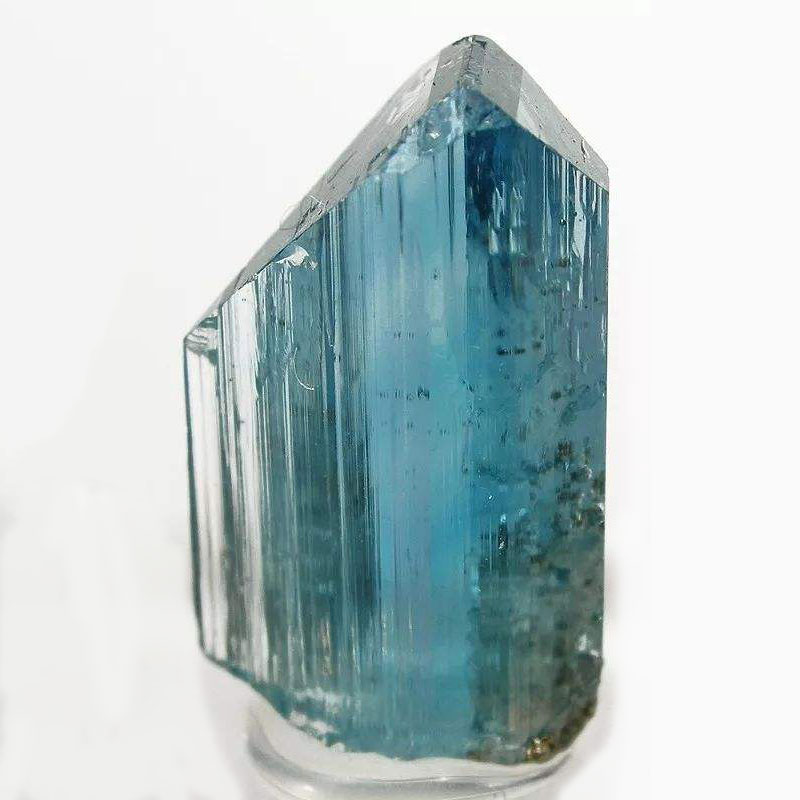Euclase is a basic aluminized metasilicate mineral. Which belongs to the Orthorhombic crystal system, the crystal is usually in a tabular and columnar shape, and the aggregate is in a granular and fibrous shape. Transparent to translucent, glass luster.
Euclase has strong pleochroic, with blue, green, yellow, and colorless colors, usually in light tones.
Euclase is brittle and has complete axial cleavage. Therefore, the English name of Euclase in Greek, “Eu, Klassis,” means cracking.
There are gem-grade crystals of different colors in the Biral Mountains of Brazil and Russia. There are three faceted Euclases from Brazil in the Smithsonian Museum in Washington, USA, which are 12.5 carats of green gemstones, 89 carats of yellow gemstones and 3.7 carats of blue-green gemstones. Other producing areas include Zimbabwe, Tanzania, Germany and Hungary.
Basic properties of Euclase
The chemical formula of Euclase is BeAL [SiO4] (OH), which belongs to the monoclinic system, and the crystals are columnar with elongation along the C-axis.
1) Mohs hardness: 7-8.
2) Cleavage: {010} cleavage is complete, (100} and {001} cleavage is incomplete.
3) Density: 3.08g/cm.
4) Optical property: inhomogeneous body, biaxial crystal, positive optical property.
5) Refractive index: 1.652~1.671, birefringence: 0.019~0.020.
6) Gloss: glass luster, pearl luster on cleavage surface.
7) Color: light blue, light green, light yellow, colorless, etc., are common.
8)Polychromism: weak to medium
9)Transparency: Transparent.
10) Origin and occurrence: It occurs in desiliconized pegmatite and chlorite schist.

Physical characteristics of Euclase
- Glass luster,
- transparent to translucent,
- light yellow, light green, green-blue to blue-green, mostly processed into gems are colorless to light blue.
- The biaxial crystal has negative optical properties.
- The refractive index is Np=1.652, Nm=1.655, Ng=1.671 (+0.006, -0.002),
- the birefringence is 0.019~0.020,
- the optical axis angle is 50 °,
- the dispersion is 0.016.
- The Polychromism is weak, and the blue shows bluish gray to light blue, and the green shows grayish green to green.
Euclase is usually inert under ultraviolet fluorescence and occasionally has weak fluorescence. Those with green blue absorption spectra have weak absorption bands at 468 nm and 455 nm, and many different colors of Euclase can show double lines at 705 nm.
How to identify Euclase
When magnified to observe the Euclase, which can have tabular inclusions and color bands. The appearance of Euclase is similar to that of beryl, but it has high refractive index and density.
Observation with a microscope may show a relatively complete cleavage surface, but it is not found in beryl. Green Spodumene is easy to mix with Euclase, but Spodumene has slightly higher density and lower birefringence.
Light color Euclase may also be mixed with Phenakite, but Phenakite is uniaxial crystal, while Euclase is biaxial crystal.
Comparison of kyanite, dumortierite and Euclase
Kyanite can be used to extract aluminum and is also a high-grade refractory material. In industry, dumortierite can be used to make the inner layer of the furnace. In addition to making gems, the plating can also be extracted from Euclase.
Kyanite is a silicate mineral with island structure, which is homogeneous with andalusite and sillimanite, and usually exists in metamorphic rocks, such as schist and gneiss.
The crystals of kyanite are columnar, flaky, and often curved, and there will also be massive, avant-garde aggregates;
The colors are various, such as blue, white, gray, green, yellow, black, etc. The uneven fracture and streak are colorless;
It has glass luster or pearl luster, from transparent to translucent. Kyanite can be used to extract aluminum and is also a high-quality refractory material.
Kyanite is mainly produced in California, Iowa, Georgia, Canada, Ireland, France, Italy, Switzerland, India, Brazil, North Korea, Australia, etc.
Dumortierite is also an island-structure silicate, which mainly exists in metamorphic rocks or pegmatites containing large amounts of aluminum.
The crystal of dumortierite is columnar, but it is very rare. The most common is the aggregate of fiber and radiation; The color is blue, violet, pink, brown, uneven fracture, and the color of streak is white; Having a glassy or dull luster, from transparent to translucent.
In industry, dumortierite can be used to make the inner layer of the furnace.
Dumortierite is mainly produced in Canada, France, Italy, Madagascar, Namibia, Norway, Poland, Sri Lanka, Arizona, California, Colorado, etc.
Euclase is a silicate mineral mainly in pegmatite and alluvial sand deposits. The crystal of Euclase is columnar; The color is colorless, blue and white, with shell-shaped fracture and white streak; It has glass luster, from transparent to translucent.
In addition to making gems, Euclase can also be used to extract plating.
In the world, the most important origin of Euclase is Minas Grice in Brazil;
In addition, Calgary Divo in Canada, the Ural Saganyeka River in Russia, Morogoro in Tanzania, Bavaria, Yali, Kashmir in Germany and other places are also important origins of Euclase.
Conclusion:
Euclase comes from two Greek words- “easy” and “broken”, meaning complete cleavage.
Euclase is a rare gem mineral rarely processed into gems, which is difficult to process due to cleavage development. Its better crystal can be used as an ornamental stone specimen.
